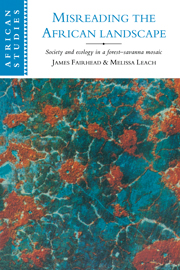Book contents
- Frontmatter
- Contents
- List of plates
- List of figures
- List of tables
- Note on authorship and research collaboration
- Acknowledgements
- Linguistic conventions
- Introduction
- 1 Convictions of forest loss in policy and ecological science
- 2 Forest gain: historical evidence of vegetation change
- 3 Settling a landscape: forest islands in regional social and political history
- 4 Ecology and society in a Kuranko village
- 5 Ecology and society in a Kissi village
- 6 Enriching a landscape: working with ecology and deflecting successions
- 7 Accounting for forest gain: local land use, regional political economy and demography
- 8 Reading forest history backwards: a century of environmental policy
- 9 Sustaining reversed histories: the continual production of views of forest loss
- 10 Towards a new forest–savanna ecology and history
- Appendix I Glossary of plant names
- Appendix II Cassette recordings of oral accounts and discussions
- Notes
- List of references
- Index
- Titles in the series
- Plate section
9 - Sustaining reversed histories: the continual production of views of forest loss
Published online by Cambridge University Press: 05 June 2012
- Frontmatter
- Contents
- List of plates
- List of figures
- List of tables
- Note on authorship and research collaboration
- Acknowledgements
- Linguistic conventions
- Introduction
- 1 Convictions of forest loss in policy and ecological science
- 2 Forest gain: historical evidence of vegetation change
- 3 Settling a landscape: forest islands in regional social and political history
- 4 Ecology and society in a Kuranko village
- 5 Ecology and society in a Kissi village
- 6 Enriching a landscape: working with ecology and deflecting successions
- 7 Accounting for forest gain: local land use, regional political economy and demography
- 8 Reading forest history backwards: a century of environmental policy
- 9 Sustaining reversed histories: the continual production of views of forest loss
- 10 Towards a new forest–savanna ecology and history
- Appendix I Glossary of plant names
- Appendix II Cassette recordings of oral accounts and discussions
- Notes
- List of references
- Index
- Titles in the series
- Plate section
Summary
The persistence of a reversed reading of Kissidougou's landscape over a century seems hard to credit. In this chapter we explore some explanations for its endurance, examining how degradation visions have succeeded in excluding other environmental perspectives, including those of local inhabitants, and thus why the vegetation changes which have occurred have been rendered invisible.
The degradation position, we will argue, has been sustained not on the basis of ignorance, but through the continual production of supportive knowledge. Those who are convinced of deforestation and savannisation do not lack ‘evidence’ to draw on in support of their convictions. At stake here is partly the inheritance and transfer of scientific ideas and supportive theories. But while tracing the genealogy of landscape readings through individuals and institutions is useful, it is also inadequate. It overlooks how successive generations of observers repeatedly ‘rediscover’ readings for themselves, within common sets of intellectual structures and social relations. The persistent conviction of savannisation, we suggest, owes a great deal to this process of continual derivation.
In this production of knowledge, the concepts and methodological structures of ecological sciences have been centrally important, but the relations of production extend beyond ‘science’ itself. This chapter therefore explores the social, political and financial conditions which have mutually supported each other in upholding this powerful backwards reading of history, and the ways that local political processes have been incorporated into it.
- Type
- Chapter
- Information
- Misreading the African LandscapeSociety and Ecology in a Forest-Savanna Mosaic, pp. 261 - 278Publisher: Cambridge University PressPrint publication year: 1996

